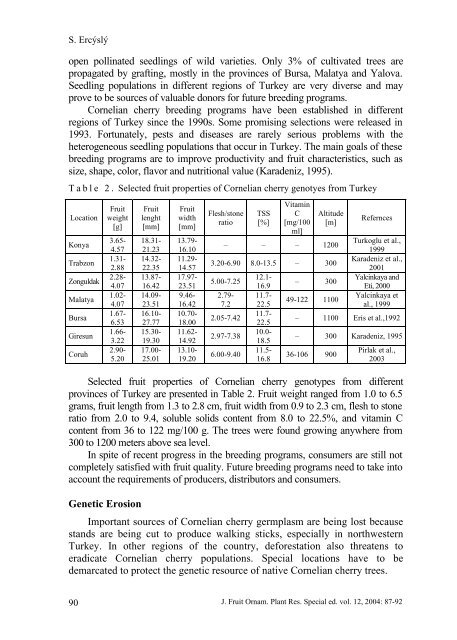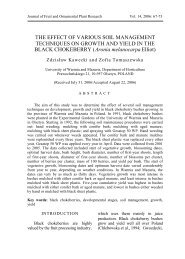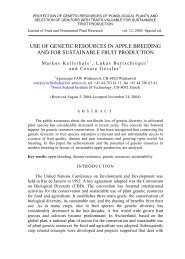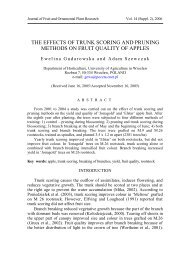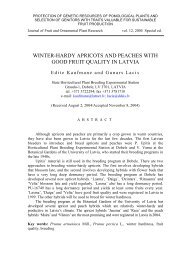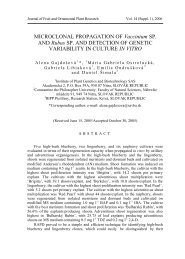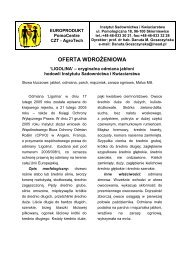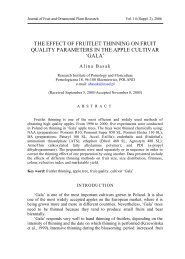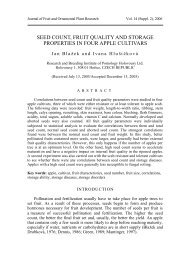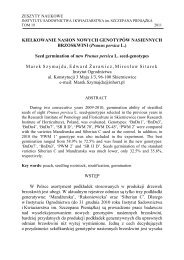Cornelian cherry germplasm resources of Turkey
Cornelian cherry germplasm resources of Turkey
Cornelian cherry germplasm resources of Turkey
You also want an ePaper? Increase the reach of your titles
YUMPU automatically turns print PDFs into web optimized ePapers that Google loves.
S. Ercýslý<br />
open pollinated seedlings <strong>of</strong> wild varieties. Only 3% <strong>of</strong> cultivated trees are<br />
propagated by grafting, mostly in the provinces <strong>of</strong> Bursa, Malatya and Yalova.<br />
Seedling populations in different regions <strong>of</strong> <strong>Turkey</strong> are very diverse and may<br />
prove to be sources <strong>of</strong> valuable donors for future breeding programs.<br />
<strong>Cornelian</strong> <strong>cherry</strong> breeding programs have been established in different<br />
regions <strong>of</strong> <strong>Turkey</strong> since the 1990s. Some promising selections were released in<br />
1993. Fortunately, pests and diseases are rarely serious problems with the<br />
heterogeneous seedling populations that occur in <strong>Turkey</strong>. The main goals <strong>of</strong> these<br />
breeding programs are to improve productivity and fruit characteristics, such as<br />
size, shape, color, flavor and nutritional value (Karadeniz, 1995).<br />
Table 2. Selected fruit properties <strong>of</strong> <strong>Cornelian</strong> <strong>cherry</strong> genotyes from <strong>Turkey</strong><br />
Location<br />
Konya<br />
Trabzon<br />
Zonguldak<br />
Malatya<br />
Bursa<br />
Giresun<br />
Coruh<br />
Fruit<br />
weight<br />
[g]<br />
Fruit<br />
lenght<br />
[mm]<br />
Fruit<br />
width<br />
[mm]<br />
3.65<br />
4.57<br />
1.31<br />
2.88<br />
2.28<br />
4.07<br />
1.02<br />
4.07<br />
1.67<br />
6.53<br />
1.66<br />
3.22<br />
2.90<br />
5.20<br />
18.31<br />
21.23<br />
14.32<br />
22.35<br />
13.87<br />
16.42<br />
14.09<br />
23.51<br />
16.10<br />
27.77<br />
15.30<br />
19.30<br />
17.00<br />
25.01<br />
13.79<br />
16.10<br />
11.29<br />
14.57<br />
17.97<br />
23.51<br />
9.46<br />
16.42<br />
10.70<br />
18.00<br />
11.62<br />
14.92<br />
13.10<br />
19.20<br />
Flesh/stone<br />
ratio<br />
TSS<br />
[%]<br />
Vitamin<br />
C<br />
[mg/100<br />
ml]<br />
Altitude<br />
[m]<br />
– – – 1200<br />
3.206.90 8.013.5 – 300<br />
5.007.25<br />
2.79<br />
7.2<br />
2.057.42<br />
2.977.38<br />
6.009.40<br />
12.1<br />
16.9<br />
11.7<br />
22.5<br />
11.7<br />
22.5<br />
10.0<br />
18.5<br />
11.5<br />
16.8<br />
– 300<br />
49122 1100<br />
Refernces<br />
Turkoglu et al.,<br />
1999<br />
Karadeniz et al.,<br />
2001<br />
Yalcinkaya and<br />
Eti, 2000<br />
Yalcinkaya et<br />
al., 1999<br />
– 1100 Eris et al.,1992<br />
– 300 Karadeniz, 1995<br />
36106 900<br />
Pirlak et al.,<br />
2003<br />
Selected fruit properties <strong>of</strong> <strong>Cornelian</strong> <strong>cherry</strong> genotypes from different<br />
provinces <strong>of</strong> <strong>Turkey</strong> are presented in Table 2. Fruit weight ranged from 1.0 to 6.5<br />
grams, fruit length from 1.3 to 2.8 cm, fruit width from 0.9 to 2.3 cm, flesh to stone<br />
ratio from 2.0 to 9.4, soluble solids content from 8.0 to 22.5%, and vitamin C<br />
content from 36 to 122 mg/100 g. The trees were found growing anywhere from<br />
300 to 1200 meters above sea level.<br />
In spite <strong>of</strong> recent progress in the breeding programs, consumers are still not<br />
completely satisfied with fruit quality. Future breeding programs need to take into<br />
account the requirements <strong>of</strong> producers, distributors and consumers.<br />
Genetic Erosion<br />
Important sources <strong>of</strong> <strong>Cornelian</strong> <strong>cherry</strong> <strong>germplasm</strong> are being lost because<br />
stands are being cut to produce walking sticks, especially in northwestern<br />
<strong>Turkey</strong>. In other regions <strong>of</strong> the country, deforestation also threatens to<br />
eradicate <strong>Cornelian</strong> <strong>cherry</strong> populations. Special locations have to be<br />
demarcated to protect the genetic resource <strong>of</strong> native <strong>Cornelian</strong> <strong>cherry</strong> trees.<br />
90<br />
J. Fruit Ornam. Plant Res. Special ed. vol. 12, 2004: 8792


